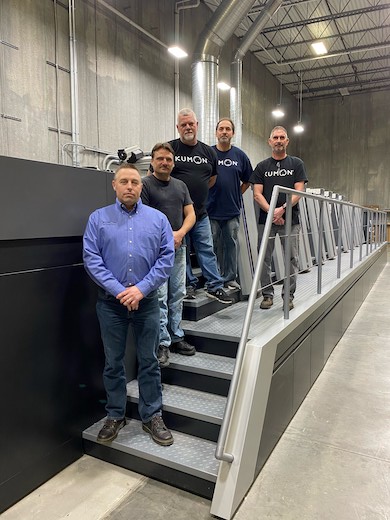Kumon North America Makes First Heidelberg Investment in Speedmaster XL 106 & Full Suite of Saphira Consumables
Press release from the issuing company

Kumon team members from left to right: Tom Mock, Bill Hartig, Joe Cosgrove, Lee Davis, Jake Backscheider with Speedmaster XL 106
Kennesaw, Ga. – The North American division of Kumon, a structured, self-learning program with educational centers located worldwide, was in need of a better solution for printing the carefully designed worksheets that make its educational model so successful. After exhaustive exploration of many press providers, Kumon made the decision to purchase the Speedmaster XL 106-9P with Push-to-Stop technology, its first ever Heidelberg investment, along with running the new press exclusively with Heidelberg’s Saphira Consumables.
Productivity Gains, Cost Savings
Printing nearly 100 million worksheets in 2019, Kumon needed to add to its existing fleet of offset presses to keep up with the demand at its Hebron, Kentucky plant. Despite having never purchased from Heidelberg in the past, Kumon selected the Speedmaster XL 106 for several key factors that made it stand out among the competition: press speed, advanced press technology & automation, Heidelberg’s vast service network, and the quick availability of parts and consumables.
“We’re able to consistently run the press at top speeds of 18,000 sheets per hour, which is significantly faster than our other two machines. This press is far more advanced than anything we’ve run before. The consistency of it is outstanding, especially since we typically run thinner, uncoated stocks,” said Tom Mock, Operations Manager for Kumon.
In addition to faster speeds, Mock credits the advanced Push-to-Stop technology on the machine for increasing the overall throughput and productivity of the plant. With AutoPlate Pro, a fully automatic plate change system, and program-controlled blanket wash-up devices for the blanket and impression cylinders, makeready times in between jobs have been cut in half versus its previous press. Due to the drastic productivity improvements, Mock says that Kumon has moved nearly 40% of the plant’s total print volume off its other two presses and onto the XL 106. These productivity gains have enabled Kumon to cut its production from a three-shift model to a two-shift model, which has resulted in plantwide cost savings. Additionally, Kumon is saving about 15% on converting costs from its paper vendors thanks to the addition of CutStar, Heidelberg’s inline roll-to-sheet device.
The Right Decision for Kumon
To achieve such drastic productivity improvements, Kumon needed to be able to continuously run the press at top speeds. Exclusively using Heidelberg Saphira Consumables, which includes everything from ink to blankets to plates and fountain solution, ensures the reliability and quality that Kumon requires from a high output press. In addition to the quality of the products, Mock is very pleased with being able to order his press supplies and wear-and-tear parts online from Heidelberg’s eShop. “It’s so convenient and easy plus most of the products arrive within a day. It’s great,” said Mock. While currently only running Saphira products on its XL 106, Kumon does intend to start testing the products on its other two presses as well.
For Kumon, the Heidelberg “experience” does not end with the press and its supplies. Mock cites the installation and training from Heidelberg’s experienced team of SystemService representatives as “second to none.” Despite the large technology leap from their current presses to the new XL 106, the press operators at Kumon were able to quickly learn the new technology and are excited about running the press. According to Mock, “During our press search, we knew that Heidelberg would be the right fit for us. Now having experience with the product and the service, we know we made the right decision.”
About Kumon North America
Kumon started in 1954 Japan when Toru Kumon helped his young son learn calculus by sixth grade. Through his unique teaching method of short, incremental assignments, other parents took notice and began teaching Kumon’s unique step-by-step learning method. Instead of taking notes, memorizing facts, and being fed information from teachers or a tutor, children actively develop critical, self-learning skills through carefully designed worksheets. In 1974, the first Kumon Math Center opened in the United States. Today, Kumon has established itself as a provider of quality education for millions of local children through local instructors in over 50 countries around the world.
© 2025 WhatTheyThink. All Rights Reserved.













